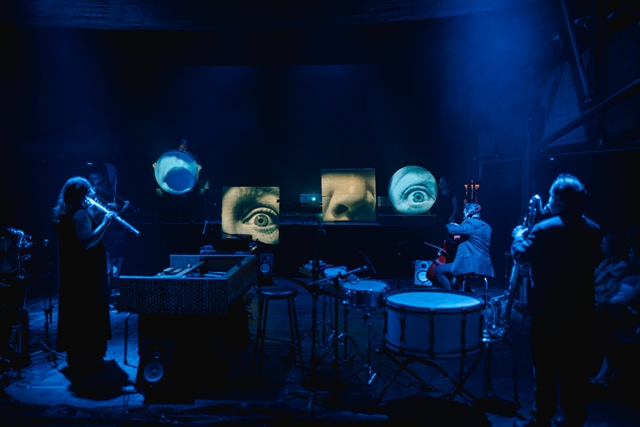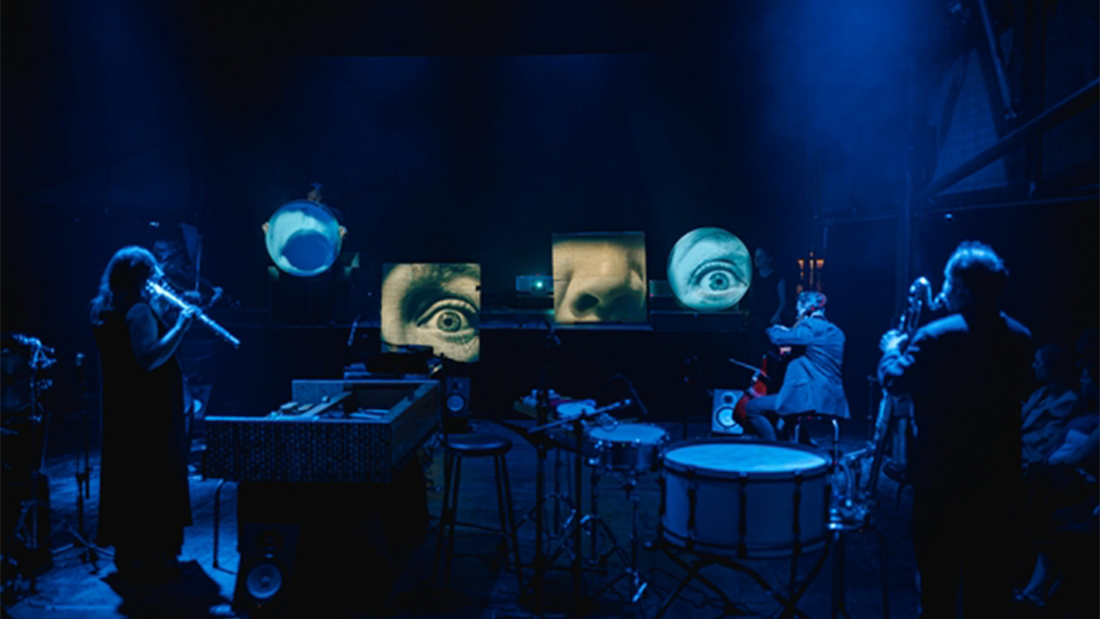
Review: Decibel at The Rechabite
Decibel at The Rechabite
Wednesday, December 13, 2023
Perth-based, internationally-renowned new music ensemble, Decibel, was formed by Cat Hope in 2009. The sextet has been performing innovative new music in Perth, around Australia, and around the world ever since and has released nine albums, two on international labels. Last Wednesday night at The Rechabite, they performed Sound Drawing in Space. Composed by a selection of profile Australian composers, all seven works were WA premieres and six were world premieres.
A fortnight earlier in Melbourne, the prolific Hope, professor of music at Monash University, premiered her latest work, Voluminum. The two shows dovetail beautifully. Both were accompanied by projected pictorial scores, but whereas Voluminum utilised graphic scores and climaxed in a wall of noise, Sound Drawing in Space was a gentle show that, through seven variants, explored the parameters of picture-oriented scores in general.
The ensemble for the one-off Rechabite show was Lindsay Vickery (clarinets), Christian Read (viola), Tristen Parr (cello, producer), Stuart James (electronica, piano harp), Cat Hope (flutes), and Louise Devenish (percussion, piano harp). With two exceptions, all are Decibel founding members. Devenish replaced Malcolm Riddoch in 2014 or thereabouts, while Read was sitting in for Aaron Wyatt on this occasion. The projected side of the show was devised by media artist Sohan Ariel Hayes in collaboration with artistic director Cat Hope. His arresting imagery both carried and counterpointed the pictorial scores.
An imaginative night, gently anarchic on just about every level, all seven composers push the frontiers of music, scoring, instruments, or performance, not just for the sake of it but, like all significant art, to make a deeper statement.
Pictorial scoring is well-suited to Decibel, and they are world leaders in this field. The Decibel Score-Player, an iPad app they developed to coordinate predominantly graphic scores, is now used by composers and ensembles the world over.
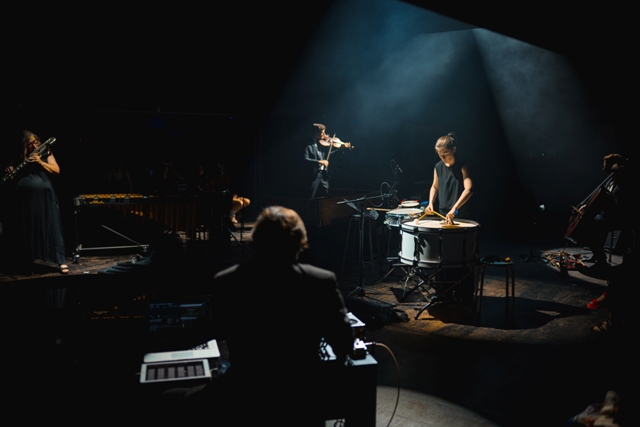
Decibel
Appropriately, the concert commenced in complete silence, but curiously, there was no noticeable cue for this. The audience seemed to know instinctively that the show was about to begin. Everyone stopped talking, then sat in silence for an extended period before the room dimmed to darkness, and Kezia Yap’s as though my ears are your ears emerged.
A low electronic rumble slowly reached perception, and then, to a rattling of chimes, four performers entered the space. In pairs, one with a hand-held light and the other with an amplified glove, they traced the walls behind the seats and strafed the room like searchlights in a night sky. Humming and strafing, they slowly made their way to the back of the hall, where, in unison, they contemplated the wall.
Yap’s process expands the musical score, in this case the lights, to invite critical listening and engage extramusical ideas. She uses space and silence to explore spatial-temporal themes such as natural and built environments or cultural and linguistic identities. In this piece, the light score prompted the audience to examine the performance space, an appropriate way to open the show.
Light was again the trigger in Jaslyn Robertson’s Shadow Aria. The six musicians took discrete positions around the room, Hope and Vickery playing the bass forms of their flute and clarinet, the whole underpinned by James’ Eno-like electronica and Devenish’s Lion’s Roar, an orchestral bass drum rumbled by a hempen cord slowly dragged over its skin. A controlled improvisation, each musician explored the static end of their instrument, while in turn, they were singled out in a circle of bright light. Subversively, when the spotlight came up on them, the performer froze, often mid-phrase, and, like an animal in the headlights, held completely still until the light went out.
The composer’s aim was to emphasise those marginalised people whose voices are silenced due to lack of opportunity and societal prejudice.
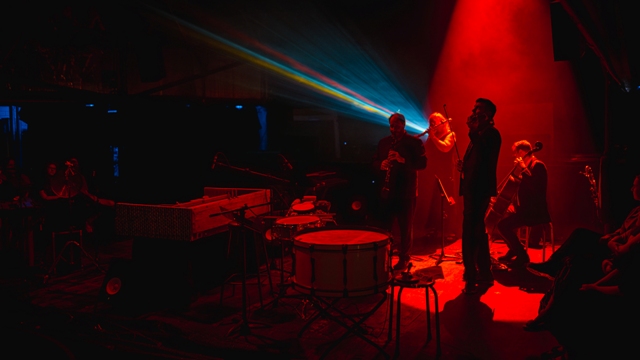
Decibel
The piece was directed by the lighting operator following the score created in the Decibel Score Player. Individual performers didn’t know when the light would single them out; it had a random spontaneity. Eventually all of the spots came on, leaving only the programmed electonica playing. Then the lights went out, everyone started playing again, and the piece ended.
Brenda Gifford’s Bardju was driven by a vivid landscape projection that slowly serpentined across the mesh barrier of the second balcony. The alto flute, clarinet, cello, and viola harmonised into a slow, sustained ascent.
Sum (some) of the Parts exploited facial expressions as the artefact of its musical score. Four improvised screens, two drum skins, and two squares of cardboard captured videographer John Montgomery’s deconstructed images of the composer, Donna Hewitt’s face. Her squinting and blinking eyes, twitching nose, and pouting mouth, rearranged Picasso-like (left eye right of the left, etc.), created a complex and all-too-human emotional landscape. The cello, viola, bass flute, and bass clarinet each followed a different screen, with the sotto voce shimmering viola and the detuning cello grounded by the winds. Ethereal, choral-like, in the middle, the images froze, then swapped to the negative. The music, wavering, quavering, and quivering, moved to a high pitch, then stopped.
The score for David Brown’s bad snake laugh began life as a rough sketch in red biro before developing into a more considered drawing in various coloured ballpoints, one for each part. The highlight of this work, though, was the meticulous destruction of an acoustic guitar. Brown (aka Candlesnuffer) is a well-known prepared-guitar performer, so Hope decided to 'unprepare' a guitar to emulate some of the sounds indicated in his piece. Vocalising gleefully, Hope and Vickery used a hacksaw, hammer, pliers, and a pair of multi-grips to completely destroy an ancient op-shop-found instrument. If you thought the destruction of guitars at the 1967 Monterey Pop Festival was wild, think again. Neither Pete Townsend smashing his Strat nor Hendrix setting his alight were a patch on this. In a moment reminiscent of the Yardbirds scene in Antonioni’s Blow Up, much to Hope’s chagrin, a member of the audience casually souvenired the tortured carcass after the show had finished.
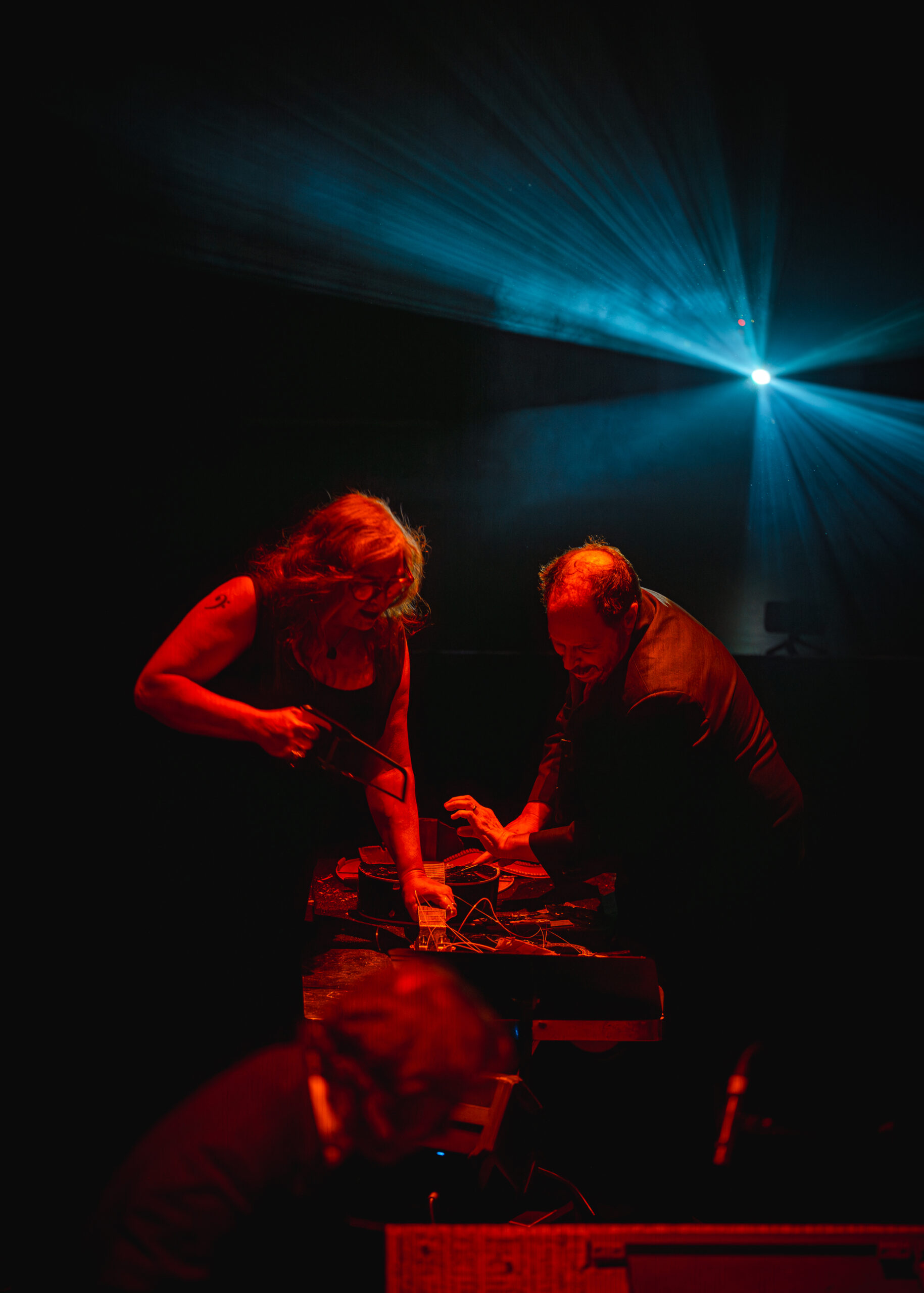
Decibel
A large wishing well projected with a one-hundred-year-old (to the day) weather forecast prompted the improvisations of Kate Milligan’s The Forecast. Starting at the centre, eight concentric, slowly-rotating text circles gradually filled the pool. Each player was assigned two 'rings': viola the outer, electronics the inner, then percussion and flute. To help the players work out which was theirs, the rings first appeared in colour. As the piece progressed, they reverted to white.
To enhance the image and comment subtly on climate change, when directed by the score, Devenish, Hope, and Read threw coins into the water.
Throughout the show, all of the performers moved around the space to take up different strategic positions. The central area, though, was dominated by Devenish’s exotic percussion instruments. On Forecast, with plain as well as stiff-bristled brushes and a set of mallets, she played a xylophone, a gong she’d immersed in water, and a small chime constructed from coins to the composer’s specifications. On the final piece, Lindsay Vickery’s after atmospheres, an adaptation of György Ligeti’s atmospheres, she was joined by Stuart James on the piano harp. A pulled-apart piano, this is what remains when you remove the front, keyboard, and their mechanisms. This instrument was on loan from Perth avant-garde music legend Antoinette Carrier. It makes an amazing sound—the stiff-bristled brushes and mallets enhanced by everyday scrubbing brushes run over the strings.
atmospheres is the piece Stanley Kubrick used at the climax of 2001: A Space Odyssey. Vickery, a prolific composer whose more than 200 works explore new forms of scoring and structure, was delighted when Hope invited him to rearrange and rework this classic score. Ironically, he once literally had a dream of doing this. For anyone who has been mesmerised by Kubrick’s masterpiece, to see and hear this familiar, haunting, and challenging piece reconstructed so expertly was a sheer delight.
Like Ligeti, Decibel’s sonic landscape is way beyond the safe and expected realms of Western music—indeed, of all music—yet it makes perfect sense and captures something fundamental and deep within the human conundrum. It is an indication of the high regard in which the ensemble is held that the audience at The Rechabite included an abundance of experimental musicians and composers, the core cohort of Perth’s long-term devotees of new music, and a veritable who’s who of its avant-garde arts producers. All up, there were some 180 people. The seats and stools on all three levels were comfortably filled. Most importantly, as you had to both see and hear this show to get the full impact, everyone had a clear view of the stage and projections.
It’s a shame that there are no other concerts planned of this quietly crazy night of phenomenal music. Hopefully that will change, as audiences the world over will be deeply impressed.
IAN LILBURNE
Photos by Edify Media

